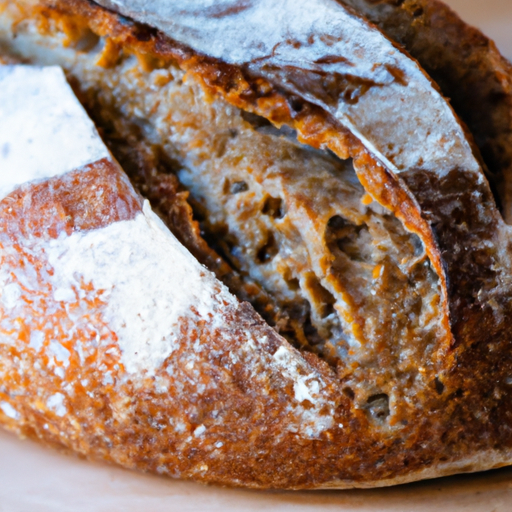Ready to take your baking skills to the next level? Look no further than the world of whole grains. Baking with Whole Grains: Healthy and Delicious is here to show you how to incorporate these nutritious powerhouses into your favorite sweet and savory treats. Packed with essential vitamins, minerals, and fiber, whole grains not only add a delightful nutty flavor to your creations but also provide numerous health benefits. Whether you’re a seasoned baker or just starting out, this article will guide you through the process of baking with whole grains, helping you create mouthwatering goodies that are both good for you and irresistibly delicious. Get ready to savor the goodness of whole grains while indulging in the sheer joy of baking!

Benefits of Baking with Whole Grains
Baking with whole grains offers numerous benefits for your health and well-being. By incorporating whole grains into your baking recipes, you can enjoy improved nutritional profile, healthier digestion, and reduced risk of chronic diseases.
Improved Nutritional Profile
Whole grains contain all parts of the grain, including the bran, germ, and endosperm. This means that they retain important nutrients such as fiber, vitamins, minerals, and antioxidants. By using whole grains in your baking, you are adding these valuable nutrients to your diet, which can help support overall health and well-being.
Healthier Digestion
One of the key benefits of baking with whole grains is their impact on digestion. Whole grains are a great source of dietary fiber, which plays a crucial role in maintaining a healthy digestive system. Fiber helps to regulate bowel movements, prevent constipation, and promote a feeling of fullness, which can aid in weight management. By incorporating whole grains into your baking, you can support a healthy digestive system and promote regularity.
Reduced Risk of Chronic Diseases
Studies have shown that consuming whole grains is associated with a reduced risk of chronic diseases, such as heart disease, type 2 diabetes, and certain types of cancer. The fiber, vitamins, minerals, and antioxidants found in whole grains work together to protect against these diseases. By including whole grains in your baking recipes, you can contribute to reducing your risk of developing these serious health conditions.
Types of Whole Grains for Baking
When it comes to baking with whole grains, there is a wide variety of options to choose from. Here are some popular types of whole grains that you can use in your baking:
Wheat
Wheat is one of the most common and versatile whole grains used in baking. It is available in various forms, including whole wheat flour, cracked wheat, and wheat berries. Whole wheat flour can be used as a substitute for all-purpose flour in many recipes, making it a popular choice for baking bread, muffins, and cookies.
Oats
Oats are another excellent whole grain option for baking. They are highly nutritious and provide a pleasant chewy texture to baked goods. Rolled oats, steel-cut oats, and oat flour are commonly used in baking recipes, such as oatmeal cookies, granola bars, and muffins.
Barley
Barley is a nutritious whole grain that adds a rich, nutty flavor to baked goods. It can be used in whole form, as barley flakes, or ground into barley flour. Barley flour is often blended with other flours to create tasty loaves of bread, biscuits, and pancakes.
Rye
Rye is a whole grain known for its distinctive flavor and dense texture. It is commonly used to make rye bread, but can also be incorporated into other baked goods, such as rolls and muffins. Rye flour is available in varying degrees of coarseness, allowing for different textures in your baked creations.
Buckwheat
Despite its name, buckwheat is not related to wheat and is gluten-free. It has a unique flavor and can be ground into flour to make pancakes, muffins, and bread. Buckwheat flour adds a rich, nutty taste to baked goods and is a great option for individuals following a gluten-free diet.
Quinoa
Quinoa is a nutrient-dense whole grain that is often used as a rice substitute in savory dishes. However, it can also be ground into flour and used in baking recipes. Quinoa flour provides a mild, nutty flavor and can be used in bread, muffins, and cookies.

Choosing and Buying Whole Grains
When it comes to choosing and buying whole grains, it’s important to know what to look for and how to store them properly. Here are some tips to help you make the right choices:
Identifying Whole Grains
When shopping for whole grains, look for products that explicitly state “whole grains” on the packaging. Check the ingredient list and ensure that whole grains are listed as the first ingredient. Look for specific types of whole grains, such as whole wheat, whole oats, or whole barley, to ensure that you are getting the full nutritional benefits.
Reading Food Labels
Food labels can provide valuable information about the nutritional content of whole grain products. Look for labels that state the amount of whole grains per serving, such as “100% whole grain” or “made with whole grain.” Be cautious of labels that may be misleading, such as “multigrain” or “wheat bread,” as they may not necessarily contain whole grains.
Buying in Bulk
Buying whole grains in bulk can save you money and ensure a steady supply for your baking needs. Look for grocery stores or specialty shops that offer bulk bins of whole grains. This allows you to buy the exact amount you need and reduces packaging waste. Make sure to store your bulk whole grains in airtight containers in a cool, dry place to maintain their freshness and quality.
Storing Whole Grains
To ensure the longevity and freshness of your whole grains, proper storage is essential. Keep whole grains in airtight containers away from heat, light, and moisture. Whole grains can be stored at room temperature for up to six months, but for longer storage, consider refrigerating or freezing them. Before using stored whole grains, check for any signs of spoilage or insects.
Substituting Whole Grains in Baking Recipes
Making the switch from all-purpose flour to whole grains in your baking recipes can be a simple and nutritious choice. Here are some tips for successfully substituting whole grains in your favorite recipes:
Whole Grain Flour vs. All-Purpose Flour
When substituting whole grain flour for all-purpose flour, it’s important to note that whole grain flours have different properties, including more fiber and a denser texture. Experiment with different ratios to find the right balance that suits your taste preferences. Start by substituting a portion of the all-purpose flour with whole grain flour and gradually increase the amount over time.
Conversion Ratios
Conversion ratios can vary depending on the recipe and the type of whole grain flour being used. As a general guideline, you can start by replacing up to 25% of the all-purpose flour with whole grain flour. For example, if a recipe calls for 1 cup of all-purpose flour, you can replace it with ¾ cup of all-purpose flour and ¼ cup of whole grain flour.
Texture and Flavor Adjustments
Whole grains can alter the texture and flavor of your baked goods. They tend to produce a denser and chewier texture compared to all-purpose flour. If you prefer a lighter texture, consider blending whole grain flour with other flours, such as all-purpose flour or a lighter whole grain flour. Additionally, the nutty and hearty flavors of whole grain flours can complement certain recipes, such as bread or muffins, but may need adjustments for sweeter treats like cookies or cakes.
Combining Whole Grains with Other Flours
To achieve the desired texture and flavor in your baked goods, consider combining different types of whole grains with other flours. This allows you to take advantage of the nutritional benefits of whole grains while still maintaining the texture and taste you desire. Experiment with different combinations to find the perfect balance that suits your preferences.

Tips for Baking with Whole Grains
Baking with whole grains can require some adjustments compared to using traditional all-purpose flour. Here are some helpful tips to ensure successful and delicious results:
Soaking Whole Grains
Soaking whole grains before using them in baking can help to soften them and improve their texture. This is particularly beneficial for grains like quinoa or millet that have a delicate texture. Soaking can also help to reduce baking time and promote even cooking.
Using a High-quality Grinder
Investing in a high-quality grinder or grain mill is essential for those who enjoy baking with whole grains. Grinding your own whole grain flour allows you to have more control over the texture and consistency of the flour. This can contribute to better baking results and fresher-tasting flour.
Adding Extra Moisture
Whole grain flours tend to absorb more moisture than all-purpose flour. Keep this in mind when adapting your recipes and consider adding extra moisture, such as additional liquid ingredients like eggs or milk, to prevent your baked goods from becoming dry or dense.
Adjusting Baking Time and Temperature
Due to the differences in texture and moisture content of whole grain flours, it may be necessary to adjust the baking time and temperature for your recipes. Whole grain baked goods may require slightly longer baking times at slightly lower temperatures to ensure even baking and a fully cooked interior.
Recipes for Baking with Whole Grains
Baking with whole grains opens up a world of delicious possibilities. Here are some recipes to inspire your whole grain baking adventures:
Whole Grain Bread
Homemade whole grain bread is a nutritious and flavorful option for your daily bread needs. Using whole wheat flour or a blend of whole grains can result in a hearty and satisfying loaf. Try adding nuts, seeds, or dried fruits for extra flavor and texture.
Whole Grain Muffins
Whole grain muffins are a great way to start your day or enjoy as a snack. Incorporate a variety of whole grains, such as oats, barley, or quinoa, into your muffin batter. Add sweeteners like honey, maple syrup, or chopped fruits for added sweetness.
Whole Grain Pancakes
Swap out regular pancakes for whole grain pancakes to start your morning off right. Use a mixture of whole grain flours, such as buckwheat, oats, or whole wheat, to create a stack of fluffy and nutritious pancakes. Serve with your favorite toppings, such as fresh fruit or yogurt.
Whole Grain Cookies
Indulge in a healthier treat by baking whole grain cookies. Experiment with different combinations of whole grain flours and sweeteners to find the perfect balance of taste and texture. Add-ins like chopped nuts, dried fruits, or chocolate chips can also enhance the flavor profile.
Whole Grain Pizza Crust
Create a wholesome and flavorful pizza crust by using whole grain flours. Wheat, rye, or a combination of whole grain flours can result in a crust that is packed with nutrients and adds an extra dimension of flavor to your favorite pizza toppings.
Adding Flavor and Texture to Whole Grain Baked Goods
Enhancing the flavor and texture of whole grain baked goods can take them to the next level. Here are some ideas to add variety and excitement to your whole grain creations:
Incorporating Nuts and Seeds
Nuts and seeds not only add a delightful crunch to baked goods but also contribute to their nutritional value. Sprinkle chopped nuts, such as walnuts or almonds, or seeds like flaxseeds or chia seeds into your batter or dough for added texture and a boost of healthy fats.
Using Dried Fruits
Dried fruits, such as raisins, cranberries, or apricots, can add natural sweetness and chewiness to whole grain baked goods. Fold them into your batter or dough to infuse each bite with bursts of fruity flavors.
Experimenting with Spices and Herbs
Spices and herbs can elevate the taste of your whole grain baked goods. Experiment with cinnamon, nutmeg, ginger, or cardamom for warm and comforting flavors. For a savory twist, try adding herbs like rosemary, thyme, or basil to your bread or pizza dough.
Adding Sweeteners and Flavors
While whole grains naturally impart a nutty and earthy flavor, you may want to add a touch of sweetness or other flavors to your baked goods. Natural sweeteners like honey, maple syrup, or molasses can enhance the taste without overwhelming the wholesome qualities of whole grains. Extracts like vanilla or almond extract can also contribute to a more complex flavor profile.
Whole Grain Baking for Specific Dietary Needs
Baking with whole grains can accommodate various dietary needs and restrictions. Here are some ways to adapt whole grain baking for specific dietary preferences:
Gluten-Free Baking with Whole Grains
For those following a gluten-free diet, there are many whole grain options available. Look for gluten-free whole grain flours, such as buckwheat flour, brown rice flour, or sorghum flour, to create delicious gluten-free baked goods.
Vegan Whole Grain Baking
To accommodate a vegan lifestyle, substitute animal-based ingredients with plant-based alternatives in your whole grain baking. Replace eggs with flax or chia eggs, dairy milk with plant-based milk, and butter with oils or vegan butter.
Low-Sugar Whole Grain Baking
Reducing sugar in your baked goods can be achieved without compromising taste or texture. Experiment with natural sweeteners like mashed bananas, applesauce, or dates to provide sweetness while adding extra moisture and flavor.
Diabetic-Friendly Whole Grain Baking
For individuals with diabetes, whole grains can be incorporated into their baking routine. Focus on whole grains with a lower glycemic index, such as oats or quinoa, and use sugar substitutes specifically designed for baking to regulate blood sugar levels.
Baking with Whole Grains for Kids
Introducing whole grains to kids’ diets can be a fun and flavorful adventure. Here are some tips and ideas to make whole grains appealing to children:
Making Whole Grains Kid-Friendly
Make whole grains more appealing to kids by creating visually appealing dishes. Use cookie cutters to shape whole grain bread or pancakes into fun and familiar shapes. Get creative with toppings, such as peanut butter and sliced fruits, to make whole grain sandwiches or oatmeal more exciting.
Creative Whole Grain Snacks
Pack a nutritious punch in your kids’ snacks by incorporating whole grains. Create homemade granola bars using whole grain oats, nuts, and dried fruits. Make popcorn with whole grain kernels and season with flavorful spices for a wholesome and satisfying snack.
Introducing Whole Grains in Baked Goods
Ease your children into whole grains by gradually introducing them in their favorite baked goods. Start by replacing a portion of the all-purpose flour with whole grain flour and gradually increase the proportion over time. Encourage them to participate in the baking process to get them excited about trying new flavors.
Whole Grain Baking as a Healthier Lifestyle Choice
Incorporating whole grains into your daily diet can have long-term health benefits. Here are some key points to consider when making whole grain baking a part of your healthier lifestyle:
Incorporating Whole Grains into Daily Diet
Replace refined grains with whole grains in all aspects of your diet, not just in baking. Look for whole grain options in bread, pasta, rice, and cereal. Enjoy whole grain snacks, such as popcorn or whole grain crackers, to satisfy midday cravings.
Benefits of Long-Term Whole Grain Consumption
Consistently including whole grains in your diet can contribute to a range of health benefits. Whole grains can aid in weight management, regulate blood sugar levels, lower cholesterol levels, and reduce the risk of heart disease, type 2 diabetes, and certain cancers.
Creating a Balanced Whole Grain Meal Plan
Create a meal plan that incorporates a variety of whole grains in your daily meals. Include whole grain bread or cereal for breakfast, whole grain wraps or salads for lunch, and whole grain pasta or rice dishes for dinner. Make sure to balance your whole grain intake with a variety of other nutrient-rich foods, such as fruits, vegetables, lean proteins, and healthy fats.
By embracing the benefits and versatility of whole grains in your baking, you can make healthier and more delicious choices for you and your family. Experiment with different types of whole grains, adapt your favorite recipes, and enjoy the satisfaction of creating wholesome baked goods that nourish your body and delight your taste buds. Happy baking!

